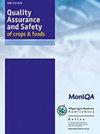田间条件下欧芹(Petroselinum crispum)农药残留的持久性和耗散行为
IF 5.3
3区 农林科学
Q1 FOOD SCIENCE & TECHNOLOGY
引用次数: 16
摘要
在田间条件下,研究了氯吡虫啉、乐果、氯菊酯、异丙酮、甲螨灵和丙土酯在欧芹中的残留水平、消散行为和日粮摄入风险。分别采用快速、简便、廉价、有效、坚固、安全的QuEChERS方法和气相色谱/串联质谱(GC/MS/MS)系统进行农药残留的提取和测定。氯吡虫啉、乐果、氯菊酯、异丙酮、甲螨灵和丙土威在欧芹中的耗散符合一级动力学,半衰期(t1/2)分别为3.33、3.30、2.94、3.52、4.10和3.38 d。根据消耗规律和最大残留限量(MRL),建议采前间隔时间(PHI)分别为25、13、18、24、1和16 d,分别为甲基毒死蜱、乐果菊酯、氯菊酯、异丙酮、甲螨灵和丙咪酯。农药的估计日摄入量为7.37E-05毫克/公斤(乐果)至8.00E-04毫克/公斤(甲螨灵)。慢性风险评估结果显示,危害商(HQ) <1,危害指数(HI) <100%,表明累积暴露于农药残留,表明摄入欧芹农药残留对人体是安全的。本文章由计算机程序翻译,如有差异,请以英文原文为准。
Persistence and dissipation behavior of pesticide residues in parsley (Petroselinum crispum) under field conditions
The residue level, dissipation behavior, and dietary intake risk of chlorpyrifos-methyl, dimethoate, permethrin, iprodione, metalaxyl, and propargite in parsley (Petroselinum crispum) were investigated under field conditions. Extraction and determination of pesticide residues were carried out by a quick, easy, cheap, effective, rugged, and safe (QuEChERS) method and a gas chromatography/tandem mass spectrometry (GC/MS/MS) system, respectively. Dissipation of chlorpyrifos-methyl, dimethoate, permethrin, iprodione, metalaxyl, and propargite in parsley followed the first-order kinetics with a half-life (t1/2) of 3.33, 3.30, 2.94, 3.52, 4.10, and 3.38 days, respectively. Based on the dissipation pattern and the maximum residue limits (MRL), preharvest intervals (PHI) of 25, 13, 18, 24, 1, and 16 days are suggested for chlorpyrifos-methyl, dimethoate, permethrin, iprodione, metalaxyl, and propargite in parsley, respectively. The estimated daily intake (EDI) of pesticides ranged from 7.37E-05 (dimethoate) to 8.00E-04 (metalaxyl) mg/kg. The chronic risk assessment showed that the hazard quotient (HQ) was <1 and Hazard Index (HI, indicating the cumulative exposure to pesticide residues) was <100%, demonstrating that an intake of pesticide residues from parsley was safe for humans.
求助全文
通过发布文献求助,成功后即可免费获取论文全文。
去求助
来源期刊

Quality Assurance and Safety of Crops & Foods
FOOD SCIENCE & TECHNOLOGY-
CiteScore
4.60
自引率
7.50%
发文量
61
审稿时长
1 months
期刊介绍:
''Quality Assurance and Safety of Crops & Foods'' is an international peer-reviewed journal publishing research and review papers associated with the quality and safety of food and food sources including cereals, grains, oilseeds, fruits, root crops and animal sources. It targets both primary materials and their conversion to human foods. There is a strong focus on the development and application of new analytical tools and their potential for quality assessment, assurance, control and safety. The scope includes issues of risk assessment, traceability, authenticity, food security and socio-economic impacts. Manuscripts presenting novel data and information that are likely to significantly contribute to scientific knowledge in areas of food quality and safety will be considered.
''Quality Assurance and Safety of Crops & Foods'' provides a forum for all those working in the specialist field of food quality and safety to report on the progress and outcomes of their research.
 求助内容:
求助内容: 应助结果提醒方式:
应助结果提醒方式:


